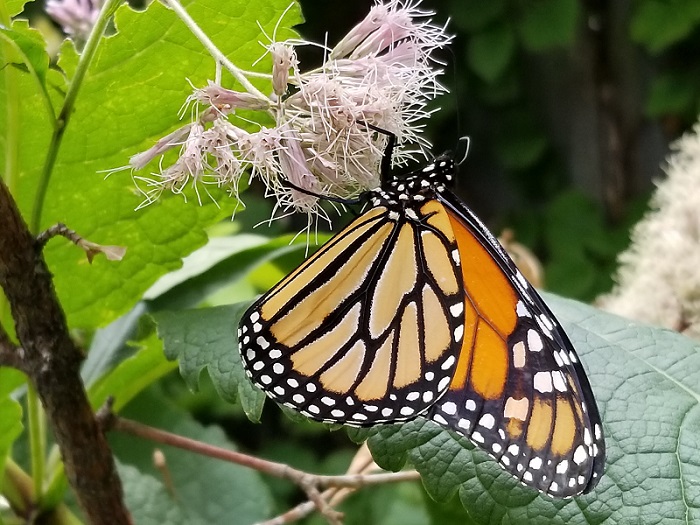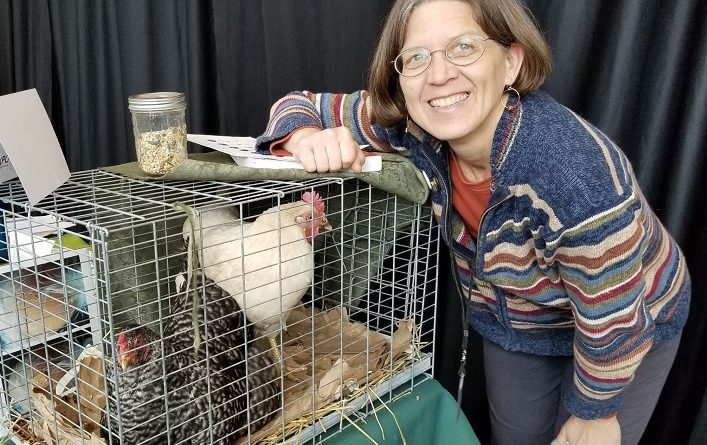Chicken Enthusiasts and Monarch Supporters
Podcast: Play in new window | Download (Duration: 1:45:57 — 48.3MB)
Subscribe: Apple Podcasts | Spotify | Android | iHeartRadio | Podchaser | Email | TuneIn | RSS | More
The chickens are in the house!
(September 16, 2018) And so are their keepers, some musicians and they’re ready to launch the 2018 Windy City Coop & Eco-Yard Tour. The event, presented by Chicago Chicken Enthusiasts, takes place over the course of two days next week–Saturday, September 22 & Sunday, September 23 from 10AM-1PM and/or 1-4PM each day.
ChiChickEns, as they are sometimes referred to, is a growing network of backyard poultry enthusiasts in and around Chicago that has several goals:
- Learning from and enjoying the flock of folks keeping urban poultry and other livestock
- Recommending and modeling good methods while dispelling mis-information
- Promoting and preserving policies that support people keeping backyard livestock and growing their own food
They have an unbelievable amount of information at their Google site, including information about how to
- Explore Resources & Links:: info, sites, workshops & local experts.
- Take the ChiChickEns Backyard Chickens Survey.
- Get ideas for Coops & Runs.
- Find sources of Feed & Supplies.
- Learn more about Eggs and about End of Life issues for backyard chickens.
- Access chicken Policies in Chicagoland and other cities, with info for neighbors & local decisionmakers.
That “Policies” link takes you to a page that has a ton of information about chicken-raising policies, including an IL Chicken Policies Google doc. Going there reveals this about raising Chickens in Chicago:
No specific regulation or permit required, also no limit on numbers or prohibition of roosters, but animals must be treated and housed humanely, and ordinances related to noise, sanitation, and other potential nuisances can apply.
Some folks might find that surprising, considering that many smaller communities often have specific, sometimes onerous language regarding keeping chickens. One other link that is definitely worth exploring on the “Policies” page is an article titled Shattering seven urban myths about raising chickens. Two of those myths are
Myth 1. Chickens carry diseases communicable to humans. Fact: The truth is that small flocks have literally no risk of avian flu transmission to humans. The 2006 Grain Report states: “When it comes to bird flu, diverse small-scale poultry is the solution, not the problem.”
and
Myth 3. Chickens cause waste and odor. Fact: A 40-pound dog generates more solid waste than 10 chickens. To be more specific, one 40-pound dog generates about .75 pounds of poop every day. Ten chickens generate about .66 pounds daily poop.
You could spend hours going down rabbit…er, chicken holes on the ChiChickEns sites. So let’s get to today’s show. Martha Boyd has been a friend of The Mike Nowak Show for years and has been on the program many times. She is Program Director for the Chicago Urban Initiative at Angelic Organics Learning Center, and manager of Chicagoland Chicken Enthusiasts and she joins us on the phone.
However, it’s going to be very interesting in the studio, with two Coop Tour participants joining us…with some chickens! Martha Boyd writes,
Suzanne Plunkett has hosted several Tours, and her chickens were models for the recent Chicago Magazine article about urban farming. One also was the featured bird for Chicken Sh*t Bingo after the 2016 Tour — which was a little stressful b/c of the ginormous quantity of mealworms that people gave that poor hen (she survived)! Suzanne also happens to be a founding member of Lifeline Theater and is a professional photographer.
In fact, Suzanne and I have known each other for far too long, and, at one time, she did my theatre head shots for me! I am looking forward to seeing her again after all these years. In case you need your own headshots done, her website is Suzanne Plunkett Photographs.
 Also in studio will be Rachel Allard, along with her sons Max and Otto. They are musicians with a band called From the Start, which features banjo and mandolin music. You can also find them on Facebook , on Instagram and on YouTube. They’re even bringing a Little Thief the Chicken, who has her own Instagram page!
Also in studio will be Rachel Allard, along with her sons Max and Otto. They are musicians with a band called From the Start, which features banjo and mandolin music. You can also find them on Facebook , on Instagram and on YouTube. They’re even bringing a Little Thief the Chicken, who has her own Instagram page!
This is going to be really fun. You should tune in.
A good year for monarch butterflies?
 I pose that in the form of a question, not because I’m on Jeopardy, but because, in the world of science, nothing is real until the data prove it. So I was intrigued a little more than a week ago when I saw a Facebook post from Doug Taron that featured a short video of roosting monarch butterflies. He wrote,
I pose that in the form of a question, not because I’m on Jeopardy, but because, in the world of science, nothing is real until the data prove it. So I was intrigued a little more than a week ago when I saw a Facebook post from Doug Taron that featured a short video of roosting monarch butterflies. He wrote,
Monarch roost outside of the #naturemuseum. This year’s migration is insane. Monarchs all over the place. A preliminary look at the Illinois Butterfly Monitoring Network data suggests that the summer of 2018 had the fourth largest monarch population of the past 25 years.
Doug Taron, PhD is Chief Curator of the Chicago Academy of Sciences (which you probably recognize as the Peggy Notebaert Nature Museum), director of the Illinois Butterfly Monitoring Network, and he’s turned into a bit of a regular on our program. While we talk about dragonflies and butterflies other than monarchs, the iconic orange and black insect is on everybody’s radar, with populations having declined by somewhere between 80 and 97% over the past twenty years.
Or has it?
Given that we didn’t even know where monarchs overwintered until the mid 1970s, could it be possible that their populations fluctuate from decade to decade on a regular basis? Get back to me in a hundred years about that. Or perhaps I’ll ask Dr. Taron when he’s in studio today. While the “official” monarch counts are the ones taken in the overwintering fields in Mexico, Taron argues that the summer counts are important, too.
And this year, the numbers in northern North America have been very good.
Why? The answer is difficult to pinpoint, Taron says. Various factors affect the species’ health, including weather, parasites and disease.
Unfortunately, the data from a single year does not indicate a long-term upswing for the Monarch butterfly, which suffered an 88 percent decline in North America from 1999 through 2012, according to the Illinois Department of Natural Resources. In Illinois, the overall population trend has neither increased nor decreased during the past several years, Taron said.
So if monarchs are migrating in record numbers, what effect does a hurricane that is producing “biblical flooding” on the Atlantic coast have on the journey south?
Any caterpillars that have not yet transformed through the chrysalis stage and into adult, winged butterflies will escape the worst of the weather by crawling down into the denser portions of the plants they are on.
Pocious noted that monarch butterflies have been observed riding out hurricanes and several weather systems many times in the past.
One more thing about monarchs, however. Over the past couple of years, we have talked to many people about the increasingly fashionable desire to raise monarchs in captivity to “help” them increase their numbers. However, Doug Taron recently posted a though-provoking article from The Xerces Society under the headline, Keep Monarchs Wild! Why captive rearing isn’t the way to help monarchs. Among the revelations of the piece:
Interestingly, a study of recoveries of tagged monarchs suggested that captive-bred monarchs have lower migration success compared to wild monarchs (Morris et al. 2015). This research suggests that captive-bred monarchs have lower fitness—a biologist’s way of saying that these butterflies are less able to survive—and thus don’t help the population as much as wild monarchs. There is broad agreement among the monarch scientific community that captive breeding and mass releases can introduce unnecessary risks to wild monarch populations.
One of the suggestions from The Xerces Society is to
Rear no more than ten monarchs per year (whether by a single individual or family). This is the same number recommended in the original petition to list the monarch under the Federal Endangered Species Act.
I highly recommend that anybody considering raising monarch butterflies read this article.

